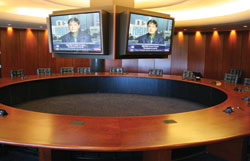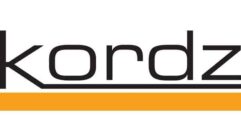

Blueprint for Success in Corporate Boardrooms
The tony corporate boardroom is a well-trod market for AV integrators, but not the most hospitable one. Some rooms are older than the oldest board members, barely wired for speakerphone, let alone stereo surround sound and high-definition plasmas. Others, the new rooms, are so image-conscious they’re built without regard for the way AV and architecture must play nicely together.
The tony corporate boardroom is a well-trod market for AV integrators, but not the most hospitable one. Some rooms are older than the oldest board members, barely wired for speakerphone, let alone stereo surround sound and high-definition plasmas. Others, the new rooms, are so image-conscious they’re built without regard for the way AV and architecture must play nicely together.
Now, ironically, AV technology is nudging some old-style boardrooms toward obsolescence while extending the lives of others. At the same time, high-quality audio- and video-conferencing have become so affordable that they are blurring corporate lines of authority and with them, the distinctions between the boardroom sanctuary and other meeting rooms.
Integrating video displays–particularly for videoconferencing–can be tough in a boardroom. Creative solutions like this one by CCS Presentation Systems can help.
Credit: Julie Solomon, CCS Presentation Systems
That was the experience of AVW-TELAV, an integrator that recently completed a multiroom installation at the Mississauga, Ontario, head office of Intuit, the maker of Quicken and TurboTax software. Intuit has a non-hierarchical culture that encourages collaboration, and its AV design reflects that, says Ken Kruse, AVW-TELAV’s Toronto regional operations manager. “The rooms are all outfitted quite extensively with audio-visual control systems,” Kruse says.
Three conference rooms have boardroom-style tables. Polycom HDX 9000 videoconferencing units and SoundStructure C12 audio digital signal processors (DSPs) were chosen as the conferencing platform, with Beyer boundary mics resting flat on the tables. AMX touch panels of various sizes provide standard controls across rooms, while Middle Atlantic hardware with rails lets equipment racks slide out from credenzas in every room.
“It’s less about a single amazing boardroom and more about the entire facility that might stretch out to six or more AV-equipped meeting rooms and digital signage,” says Byron Tarry, AVW-TELAV’s general manager for systems design and integration. “What was the jewel in the crown in the past–the boardroom–in my opinion has started to fade a little bit.”
One reason, Tarry says, is viewing distances and ceiling heights of many boardrooms don’t lend themselves to a good AV experience. Another is the traditional focus on visual extravagances, such as glass tables, marble floors, and floor-to-ceiling windows. “We build these beautiful rooms that might be acoustic nightmares,” he says.
Such constraints can make existing boardrooms ill suited to the collaborative technology many companies are embracing as a management strategy.
“Videoconferencing is not very effective in a 30-foot boardroom,” Tarry says. Besides, the increasing affordability of ultra-realistic telepresence conferencing makes it possible to create a virtual boardroom out of smaller, geographically dispersed videoconferencing rooms. “I chop my boardroom table into three or four different pieces and ship them around to three or four places,” he says.
“What makes a boardroom may or may not be defined by the AV,” says Tim Cape, principal consultant at the design firm Technitect. A boardroom, after all, is just one type of conference room, typically differentiated by its high-end furniture, wall coverings, and other touches, such as covered or recessed projector screens or video displays, Cape explains. Rear projection is used more frequently in boardrooms than in typical conference rooms, and both projector and screen are more likely to be motorized and retractable from the ceiling, he says.
Blueprint for Success in Corporate Boardrooms
The tony corporate boardroom is a well-trod market for AV integrators, but not the most hospitable one. Some rooms are older than the oldest board members, barely wired for speakerphone, let alone stereo surround sound and high-definition plasmas. Others, the new rooms, are so image-conscious they’re built without regard for the way AV and architecture must play nicely together.
Looking Good on Screen
At board meetings, people expect to hook up their laptops for power, VGA, and network connectivity. Keep the connection points within a reasonable distance and make it so they disappear.
Credit: Julie Solomon, CCS Presentation Systems
Still, the seasoned AV designer can create a boardroom experience to suit the client’s needs, whether the room is already built or will be soon.
Room size dictates display choice, Tarry says. Small- to medium-size rooms might get by with an LCD monitor, but larger rooms need projection. Front projection is the most affordable but might not suit room conditions or the image the company wants to present. “The highest-end boardrooms typically end up with a rear-projection environment,” he says.
Screen size, placement, and type are crucial in boardroom design, because the rectangular or oblong shape of the typical conference table ruins some viewing angles, and adding individual or shared monitors is usually not feasible for aesthetic and practical reasons, Cape says.
Videoconferencing adds its own concerns about camera sight lines. Cape says designers and integrators should discuss the issue with clients, perhaps recommending non-traditional table shapes, such as trapezoids.
Screen content is typically a Microsoft PowerPoint presentation delivered from a computer connected at a podium, if there is one, or to a data port located in the table or on a wall near the seat of the chairman or an executive assistant.
Switching hardware is needed in the closet to allow switching among content sources–most often PCs and videoconferencing systems–and usually transmitting it to the room’s single display, though increasingly one that shows multiple windows, Tarry says.
“That’s the chassis of the car,” he says. “It better be pretty solid to last for the next 10 years.” The equipment rack isn’t always in a closet or even in credenzas like at Intuit; Tarry knows of one at Microsoft that is built into the pedestal of a boardroom table. “The location of that head-end equipment tends to be fairly irrelevant,” he says.
As the palette of content sources broadens, the system must accommodate its variety, Tarry says, much of which comes increasingly from an Internet-connected PC. “We typically say, ‘Put a PC in the room; the PC is your window to the world.’?” The computer typically goes in the closet, and users in the room control it through a wireless keyboard and mouse or, sometimes, an interactive display device such as the Smart Board from Smart Technologies.
Nonetheless, permanent interactive PCs aren’t common in boardrooms, even if notebook PCs running the ubiquitous PowerPoint presentation are. “A boardroom, in itself, tends not to be so much about interaction,” Tarry says, “but more about presentation.”
Blueprint for Success in Corporate Boardrooms
The tony corporate boardroom is a well-trod market for AV integrators, but not the most hospitable one. Some rooms are older than the oldest board members, barely wired for speakerphone, let alone stereo surround sound and high-definition plasmas. Others, the new rooms, are so image-conscious they’re built without regard for the way AV and architecture must play nicely together.
At board meetings, people expect to hook up their laptops for power, VGA, and network connectivity. Keep the connection points within a reasonable distance and make it so they disappear.Photo: Julie Solomon, CCS Presentation Systems
Controlling Types
The touch panel, the other display in the room, ideally provides simple buttons for turning systems on and off and selecting sources. Simplicity is the watchword, and not just because it can keep support calls to a minimum. In boardrooms, egos and personal impressions are important, especially in remote conferencing.
“They will not tolerate the failure of that system to work when they have a lot of money on the line in a meeting,” Kruse says. “They don’t want to look inept.”
To avoid such embarrassments, AVW-TELAV typically has a 30-day “burn-in” period when it makes adjustments to the touch panels and back-end control systems based on its own testing and customer feedback.
Standardizing user interfaces and equipment across rooms in the same building can also reassure customers by building redundancy in case of a failure in one room, Kruse says. He adds that a spare projector will be kept in the Intuit building.
With so many people bringing laptops to meetings, it is necessary to provide hookups for power, VGA, and the local Ethernet network within a reasonable distance from each seat.
The typical approach is to have hideaway connector plates in two or three places along the tabletop. Intuit, for example, used Cable Cubby 600 enclosures from Extron in its conference room tables, Kruse says.
Blueprint for Success in Corporate Boardrooms
The tony corporate boardroom is a well-trod market for AV integrators, but not the most hospitable one. Some rooms are older than the oldest board members, barely wired for speakerphone, let alone stereo surround sound and high-definition plasmas. Others, the new rooms, are so image-conscious they’re built without regard for the way AV and architecture must play nicely together.
The Sound of Business As Usual
At Newmont Mining Headquarters, Image Audiovisuals of Denver integrated the boardroom’s audio system into the table and put all racks in a central location.
Credit: Julie Solomon, CCS Presentation Systems
Besides presentation technology, audio remains a common AV element in all boardrooms. But Tarry says it increasingly plays second fiddle to videoconferencing and architectural glitz when corporations set out to design new boardrooms. This is unfortunate, because oversized, AV-hostile rooms can make meetings less effective, especially if participants become fatigued from trying to listen through poor acoustics.
Audio decisions, such as microphone and speaker placement, become critical. “As you double the distance away from a speaker, you get one-quarter of the sound,” Tarry says. Place a microphone twice as close to the HVAC system as to the speaker that’s transmitting its output, and you can end up with a 16-times increase in ambient noise. Though it is possible to overcome such problems by throwing money and technology at them after the fact, it is better to control the entire design of the room up front, Tarry says. Often the simplest solution is a few well-placed ceiling speakers.
Not everyone has videoconferencing, but everyone has audioconferencing, commonly in the form of the tabletop “speakerphone.” Thus the closet will contain an audio DSP that mixes inputs and outputs and reinforces sound, and has the capacity to handle all the microphones in the room.
Few things are as annoying as having remote voices drowned out by the incessant clatter from typing too close to microphones. To ensure that everyone in the room or at the remote site can hear, audio engineers must carefully model or calculate acoustic conditions, such as the ambient noise from HVAC systems, as well as direct-to-reverberant ratios and signal-to-noise ratios, says Scott Woolley, director of product marketing for professional audio at ClearOne.
“There’s no guessing involved,” Woolley says. “If I don’t know the answers, I engineer it. Do the math.”
It’s also important to understand the corporate culture and provide a reality check about the acoustic impact of client requests, Woolley says. For example, a client who specifies ceiling microphones to accommodate movable furniture might need to be dissuaded because the microphones will pick up more ambient noise.
Sound reinforcement is sometimes needed to aid communication just among people in the room, especially in larger spaces.
Mixers have “voice lift” features that let you raise the decibel level of ceiling speakers. DSPs like ClearOne’s ConvergePro and Polycom’s SoundStructure can balance the audio conditions of remote and local conferees while handling sound reinforcement within the boardroom. For example, ConvergePro can turn off echo cancellation, which introduces a tiny amount of latency that is unnoticeable during remote conferences, but undesirable when the amplified participants are only in the boardroom, Woolley says. He cites as an example ClearOne’s Converge 1212A, an amplified matrix mixer with feedback elimination but no echo cancellation.
SoundStructure’s dual-reference capability provides similar benefits, according to Jim Smith, Polycom’s technical channel manager. “You can have the two systems working simultaneously with no echo at the far end,” Smith says. “There are active reference points for both the telephone and audio and video sources. The inputs and outputs of SoundStructure act like transformers.”
SoundStructure is unique in that it allows remapping of wiring changes by a simple drag-and-drop operation in software, without having to make physical changes on site, Smith says.
Boardrooms often have double doors that keep sound inside. Cape says a common tool for designing sound-proofing is the sound transmission class (STC) rating, a measure of the decibel reduction provided by partitions. Higher ratings of doors and walls can help ensure privacy between the boardroom and adjacent rooms and corridors. Adds Woolley: “Some people put speakers out in the corridor and run white noise.”
It’s more important than ever to enable reliable audio recording due to corporate accountability laws such as Sarbanes-Oxley. That typically means a dedicated media server that uses PC hardware and software to record on hard disks, with perhaps extra levels of redundant disk storage if fail-safe archiving is needed.
Woolley says a good matrix mixer can handle the extra audio path that must be dedicated to the recording devices alongside those for local and remote audio. “You need microphones that are automatically activated when someone speaks,” he says, along with a mixer that can bypass feedback elimination and echo cancellation on the dedicated audio path to ensure they don’t block voices that must be recorded. Woolley cites the FTR Gold family as an example of media servers targeted to courtroom and boardroom recording. Video-conferencing vendors also offer archiving servers. Polycom’s, for example, is called the RSS 2000, Smith says.
Blueprint for Success in Corporate Boardrooms
The tony corporate boardroom is a well-trod market for AV integrators, but not the most hospitable one. Some rooms are older than the oldest board members, barely wired for speakerphone, let alone stereo surround sound and high-definition plasmas. Others, the new rooms, are so image-conscious they’re built without regard for the way AV and architecture must play nicely together.
Business Plans
Glass walls and doors can prove tricky. That glass wall in the NeuStar boardroom? It changes from opaque to transparent, offering a view of a control room.
Credit: Julie Solomon, CCS Presentation Systems
Boardroom AV is being dictated by the same technology trends that are affecting the entire industry. HD is an obvious requirement for rooms that tend to get the most generous budgets. Interactive displays, such as the Smart Board, are increasingly common for the front-of-room display. Collaboration software, already commonplace in other meeting spaces, is another option that more corporations are considering for their boardrooms. Wireless audio and Internet are also making inroads.
As a result, future-proofing a boardroom infrastructure is indispensable. “Any time you’re building any room out, you need to [ask] ‘What’s the lifetime of this room,’ and ‘Can I build an infrastructure that will support that lifetime,'” Tarry says. “It’s easy to replace the projector, but do I really want to tear out all the switching equipment? It’s difficult. We’re in this transition between analog and digital.”
Rather than making boardrooms obsolete by effectively virtualizing their functions, good audio- and videoconferencing technology could save a few by helping them earn their keep.
The traditional boardroom “appears on the books as a beautiful, cost-weighted, unavailable resource to the corporation,” Smith says. “The opulence of the space becomes kind of an ego stroke.” In these times of bankruptcies and bailouts, upgrading a boardroom’s conferencing hardware so that well paid executives can spend resources more efficiently might be the best image-booster of all.










